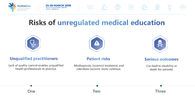Barkhadle1520
VIP
https://www.researchgate.net/publication/390551433_Medical_Education_and_Regulation_in_Somalia
In 1966, the first Nursing school was established in Hargeisa. In 1973, the Faculty of Medicine was opened at the Somali National University (SNU) in Mogadishu. The Faculty of Medicine at SNU was the only Medical school in the whole country to train Medical Doctors (MDs). It received technical and academic support from both Soviet and Italian partners offering a full 6-year medical degree program.

During the Civil War, it was looted and most of the staff fled.

The Rapid Post-war Recovery and Progress of Medical Education in Somalia :
From 1991 to 2025, there has been an increase of 112% in Professional Health Training Institutions in Somalia, going from only 1 before the civil war to 112.
(Don't pay attention to sudden drop in 2020, the government ordered schools to close for a while and do online classes but the stats don't show when they re-opened)

As of July 2025, there are 26 out 112 Professional Health Training Institutions recognized and catalogued in the World Directory of Medical Schools. Most are in Mogadishu but there is one in Borama, one in Burco, one in Bossaso, one in Galkacyo, one in Kismayo, and finally 4 in Hargeisa.
https://search.wdoms.org/?_gl=1*194...yNDE4NTEkbzEkZzAkdDE3NTIyNDE4NTEkajYwJGwwJGgw


I was very surprised to learn that this was more than twice Kenya's amount

Kenya has many nursing and mid-wifery schools but from 2004 to 2012 they went from only 2 to 12 medical schools
https://www.researchgate.net/public..._child_and_adolescent_healthcare_in_Kenya#pf2

The Steep Growth of Health Professions Education :
According to this survery, up to 82% of graduates were from health professions education indicating a bright future for Somali Medicine. The majority studied Nursing or Public Health at 33% and 22%, with only 15% studying General Medicine and 12% Midwifery.

Another study in 2020 confirmed these stats with majority of graduating undergraduate students being from medical-related faculties, exceeding education and arts graduates combined.

In 1966, the first Nursing school was established in Hargeisa. In 1973, the Faculty of Medicine was opened at the Somali National University (SNU) in Mogadishu. The Faculty of Medicine at SNU was the only Medical school in the whole country to train Medical Doctors (MDs). It received technical and academic support from both Soviet and Italian partners offering a full 6-year medical degree program.
During the Civil War, it was looted and most of the staff fled.
The Rapid Post-war Recovery and Progress of Medical Education in Somalia :
From 1991 to 2025, there has been an increase of 112% in Professional Health Training Institutions in Somalia, going from only 1 before the civil war to 112.
(Don't pay attention to sudden drop in 2020, the government ordered schools to close for a while and do online classes but the stats don't show when they re-opened)
As of July 2025, there are 26 out 112 Professional Health Training Institutions recognized and catalogued in the World Directory of Medical Schools. Most are in Mogadishu but there is one in Borama, one in Burco, one in Bossaso, one in Galkacyo, one in Kismayo, and finally 4 in Hargeisa.
https://search.wdoms.org/?_gl=1*194...yNDE4NTEkbzEkZzAkdDE3NTIyNDE4NTEkajYwJGwwJGgw
I was very surprised to learn that this was more than twice Kenya's amount
Kenya has many nursing and mid-wifery schools but from 2004 to 2012 they went from only 2 to 12 medical schools
https://www.researchgate.net/public..._child_and_adolescent_healthcare_in_Kenya#pf2
The Steep Growth of Health Professions Education :
According to this survery, up to 82% of graduates were from health professions education indicating a bright future for Somali Medicine. The majority studied Nursing or Public Health at 33% and 22%, with only 15% studying General Medicine and 12% Midwifery.
Another study in 2020 confirmed these stats with majority of graduating undergraduate students being from medical-related faculties, exceeding education and arts graduates combined.

